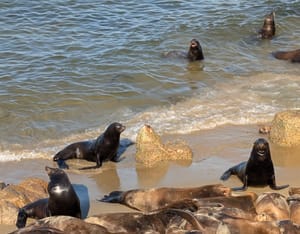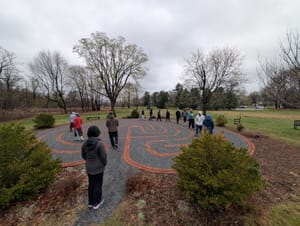It’s November, and in the seasonal ebb and return of the San Francisco economy that means it’s time for Dreamforce, the annual tradeshow hosted by Salesforce.com. It’s one of several annual conferences large enough not only to occupy all of the Moscone Center’s three massive buildings, but to spill out into and take over the adjacent street, occupying a full city block of Harrison Howard Street. As a demonstration of corporate power’s dominance over civic power in the 21st century, you don’t get much more vivid than this: A heavily used street is closed down and given over to private use, traffic is redirected at great inconvenience and cost, and the police are called in to protect and preserve this now-private space for the duration of the weeklong conference. Plus there is most of a week before given over to setup and a few days after for teardown.
This is the first issue of my new email newsletter, Postcards from the Waterline. Please sign up if you’d like to get issues direct to your inbox!
In this privatized city block, Salesforce will erect pavilions, roll out Astroturf, set up food kiosks and stages for entertainment — and all for the benefit of its paying customers. Last year there was even a private “park,” with temporary trees and greenery, with signage that echoed the National Park system’s. At a time when the real National Parks are being starved of operating budgets and their irreplaceable natural wonders are being reconsidered as concessions to be developed by the gods of capital — hotels! amusement park rides! Wi-Fi! — the irony of a miniature “National Park” popping up in San Francisco, but designated for the exclusive use of Salesforce customers, struck me as more than a little ironic.
Yes, Dreamforce brings dollars to the city, and to its hotels and restaurants in particular. Such is the deal: Give us temporary use of your public spaces and in return we will pay you, while those who are paying us will also pay you.
At least it’s temporary, and the expenses (extra policing, traffic control, etc.) are paid for by Salesforce, so unlike, say, a publicly funded sports arena there is no economic hangover after the circus leaves town.
This year, Dreamforce again includes a group of monastics from the Plum Village community founded by Thich Nhat Hanh, the second-most famous Buddhist in the world. These brown-robed Zen monks and nuns are offering meditative walking and mindful eating sessions to Dreamforce attendees, in and around a Plum Village Center within Moscone. Again, it’s complicated: “The practice of mindfulness is deeply rooted in Salesforce culture,” the website tells us, and that no doubt helps the company and its employees be more present and aware of the world and their effects on it. The addition of a meditative, spiritual component within a conference that Dan Lyons called a “triumph of vulgarity and wasteful spending” seems like a beneficial balancing element, a beacon of hope for the lost souls stuck in the pit of Mordor. To have a place of refuge, where people can escape the teeming, noisy, busy halls of the tradeshow, is certainly a relief. It may even help make the attendees better people, as meditation and the practices of the Plum Village community have undoubtedly made me a better person.
Salesforce founder Marc Benioff is a longtime supporter of Thich Nhat Hanh, and even offered up his San Francisco home as a residence for Nhat Hanh and his monks and nuns after the latter suffered a stroke in 2015. For months, Nhat Hanh received treatment at UCSF, while dozens of monastics resided in Benioff’s house, accompanying and supporting their teacher. Such relationships, between wealthy patrons and famous monks, have been essential for the continuation of monasteries throughout millennia.
But what is the function, commercially speaking, of a group of Zen monastics in the heart of a tradeshow? What benefit does Salesforce receive for including these monks and nuns? Are they merely a distraction? Another form of entertainment? A way for Salesforce to convey how hip and “different” it is?
Like the word “Dreamforce,” the effect leaves me a bit confused. The combination of something diffuse and spiritual — a dream — with the hard-edged charisma and implied threat of “force” — is a bit like an iron fist in a velvet glove. It’s easy to take it superficially, and be calmed and reassured by the fuzzy exterior, only to be brought up short by the solid material realities: The street is closed, Salesforce owns it this week, and they’re using it for a festival of sales optimization, data collection, customer tracking, and revenue generation.
***
November is also the time, in the Bay, when the water takes a turn toward the cold. After hovering in the mid-low sixties (Fahrenheit; 60F is equivalent to about 16 degrees Celsius) throughout September, the temperature drops to the high fifties in October and then hits 55 (13C) and keeps dropping in November. This is where things get real. Every degree colder is a noticeable, uniquely different experience. Going from 55 to 54 feels bracing, 53 starts to feel painful, 52 is difficult to face, 51 shockingly cold, and anything at or below 50 (10 degrees C) starts to feels positively icy. We’re not yet at the lower end of that range, but you can feel it coming, the cold, lurking out there beyond the Golden Gate like a massive, liquid mountain of anti-heat, drawing closer every week and bringing cold currents with it. For the cold water really does originate out at sea, welling up from the depths, and as fall advances into winter the tides pull more and more of these ribbons of cold into the Bay, mixing them and swirling them around before flushing them back out to sea. Meanwhile there is less sun every day to shine on the waters in the shallow parts of the Bay, so the warming that happens in the summer is curtailed. It’s as if the front door has been opened to the cold and the heater shut off at the same time: Very quickly the house gets to be the same temperature as the outdoors.
For those of us who swim in the Bay, a regular schedule is key to maintaining one’s cold-water acclimation during these waning months of the year. If you were swimming comfortably without a wetsuit in September when it was 65, you can continue comfortably at 55 provided that you kept swimming at least a couple of times a week during the month that the temperature was dropping. Twice or three times a week is plenty for your body to adjust — and it can and will adjust magnificently— provided you are relatively consistent about it. Unfortunately for me, I have only managed to swim once every week or two for the past couple of months, so I’m not having an easy time of it. I have enough cold water experience that I’m not totally unprepared, and my body adjusts quicker than it did a few years ago when I first started swimming in the Bay, but I still exercise caution. I’m not spending much more than half an hour at a time in the water, and I’m keeping to the safer waters inside Aquatic Park rather than venturing further away from the shore, the showers, and the sauna. I’ve already heard a couple of stories about swimmers experiencing hypothermia, one of whom had to be taken to the emergency room, and I’m not about to put myself in that situation if I can help it.
So there I am, when I swim, diving into “bracing” water and reminding myself how good it is for my heart, my brain, and my mental attitude. It takes my breath away, every time.


